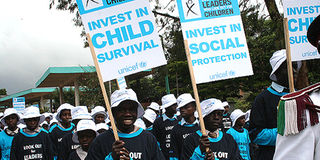Alarm as 15,000 children lured into prostitution

Child rights campaigners in a past demonstration. A Unicef survey shows that as many as 3,000 children are engaged in prostitution full time at the Kenyan coast. Photo/FILE
What you need to know:
- Unicef study shows tourists take advantage of poverty to exploit young boys and girls
Sea, sun and sand have traditionally attracted holidaymakers to Kenya’s Indian Ocean coast. But a new report says there is another kind of tourist who has made the coast his destination for all the wrong reasons.
The report by the United Nations Children Fund (Unicef) says a growing number of people visit the area not for its postcard sunsets and palm-fringed beaches but to exploit children sexually. The practice has come to be known as child sex tourism.
According to the report, between 10,000 and 15,000 boys and girls at the Kenyan coast are involved in sex work. Of these, as many as 3,000 are engaged in sex work full time.
The report is based on a 2006 study of the practice in different places in Coast Province, including Mombasa, Mtwapa, Shanzu, and Malindi.
Major reason
Most of the respondents in the Unicef survey cited poverty as a major reason for involving themselves in prostitution.
“It is a tragedy that although coastal Kenya has been the traditional tourism destination, it lies among the country’s poorest regions, and residents look to sexual exploitation as a source of income,” said Dr Ben Sihanya, a law lecturer at the University of Nairobi.
Despite the presence of many of the country’s top hotels and resorts in the province, little, if any, of the income generated by these establishments goes into improving the lives of local residents.
In the case of establishments with foreign ownership or Kenyan owners who expatriate profits, much of the money generated either never even enters the country or is sent abroad.
This, the report says, makes the environment conducive to sex tourism and child prostitution.
“With a weak local economy, insufficient funds from tourism trickling down to the communities, high levels of poverty and a large number of tourists with the perception that the their holiday is incomplete without a sexual encounter with the local population, sexual exploitation will continue to thrive,” the report says.
The report describes the practice as “the meeting point of different needs’,” saying the only way it will end is when alternatives to meeting these needs are found.
Contrary to the belief that foreigners fuel the illicit sex trade, the study found out that 39 per cent of the clients were Kenyan men, who also doubled as a link between the children and foreign clients.
“The child sex workers provide sexual services to Kenyan hotel workers and beach boys in order to access tourists,” the report says.
Condom use was found to be lowest among Kenyan, Italian and German men. Italians, Germans and Swiss ranked highest among clients who preferred under- age girls.
“These three nationalities were significantly more active with underage girls than other nationalities,” according to the report.
It also emerged that a majority of the children involved in sex work in Coast Province came from outside the province. Some came from as far as Nairobi, Kisumu, Kirinyaga, and Eldoret and were taken to the coastal towns under various pretences only to end up as sex workers.
The children operate in various places, including beaches, lodges and bars where owners at times allow them (the children) in to boost the number of patrons.
The report cites Malindi as one of the child sex hot spots where the presence of boys and girls greatly influences the patronage of bars and clubs.
The report further states that the legal requirement that bar owners demand proof that patrons are at least 18 does not succeed in keeping underage children out.
“Many of these children hold fake ID cards which are easy to get,” says the report.
In the same town, the report indicates, a certain bar enforced the ‘No children allowed’ rule for some time then stopped after the number of patrons dropped by more than 50 per cent.
In recent months, Kenya has come under criticism for failure to implement child protection laws. Some critics claim that in many cases the authorities worked hand in hand with people in the illicit trade.
“It is a failure of both policy and administration. It is only through policy that we can stop the perceived push factors that make child prostitution thrive, and we can reduce it by enforcing the existing laws,” Dr Sihanya said.
Initiated into trade
Although the report indicates that more than 46 per cent of those working as underage commercial sex workers were initiated into the trade when they were between 12 and 13 years old, the society in which they live in does not consider underage prostitution a danger.
“Most striking is the extent to which girls’ involvement in prostitution is regarded as normal and acceptable,” says the report.
But some respondents said children as young as six are involve in the sex business.
Dr Sihanya said child prostitution flourishes because many people in the area focus on the short-term benefits and ignore the obvious dangers of the trade including the spread of HIV, unwanted pregnancies and criminal behaviour.




